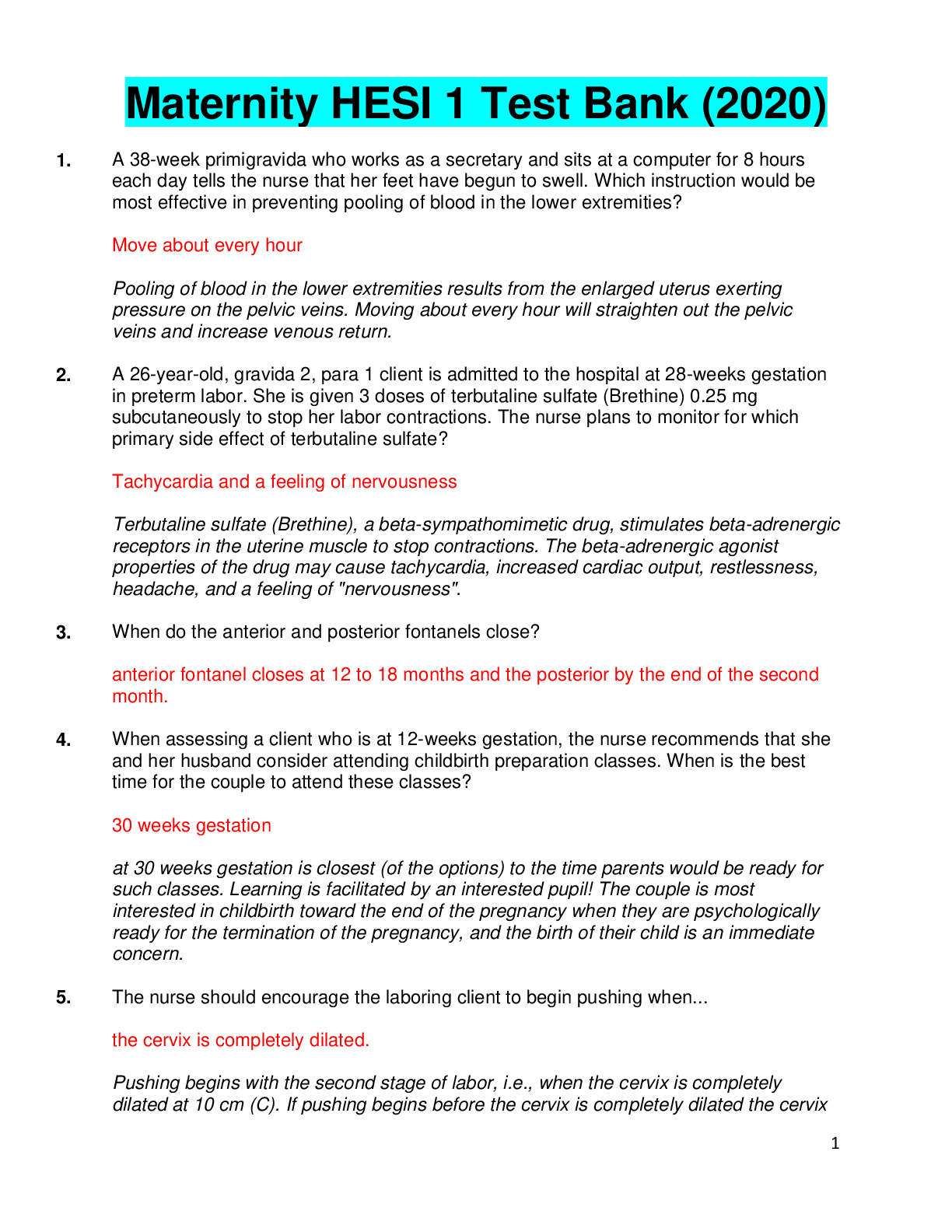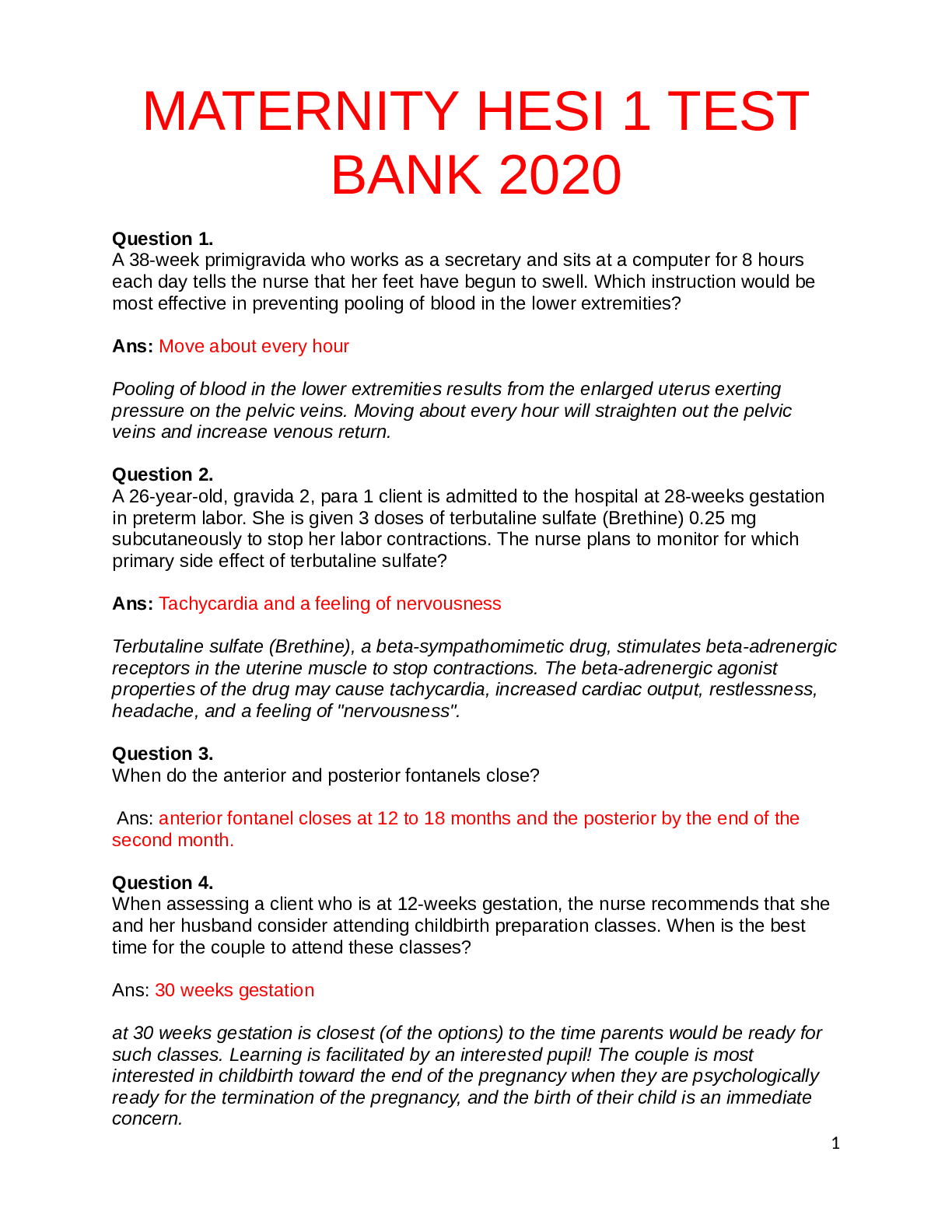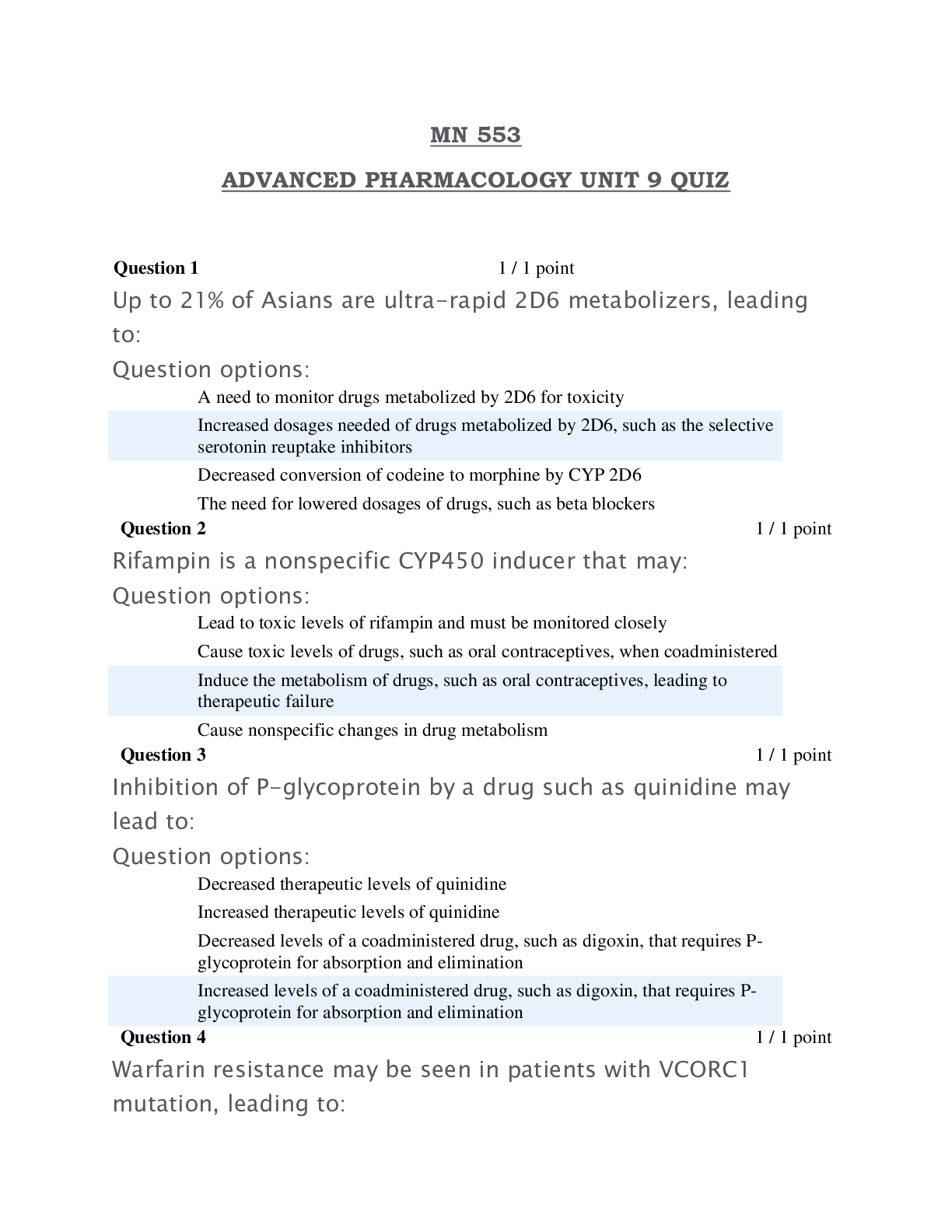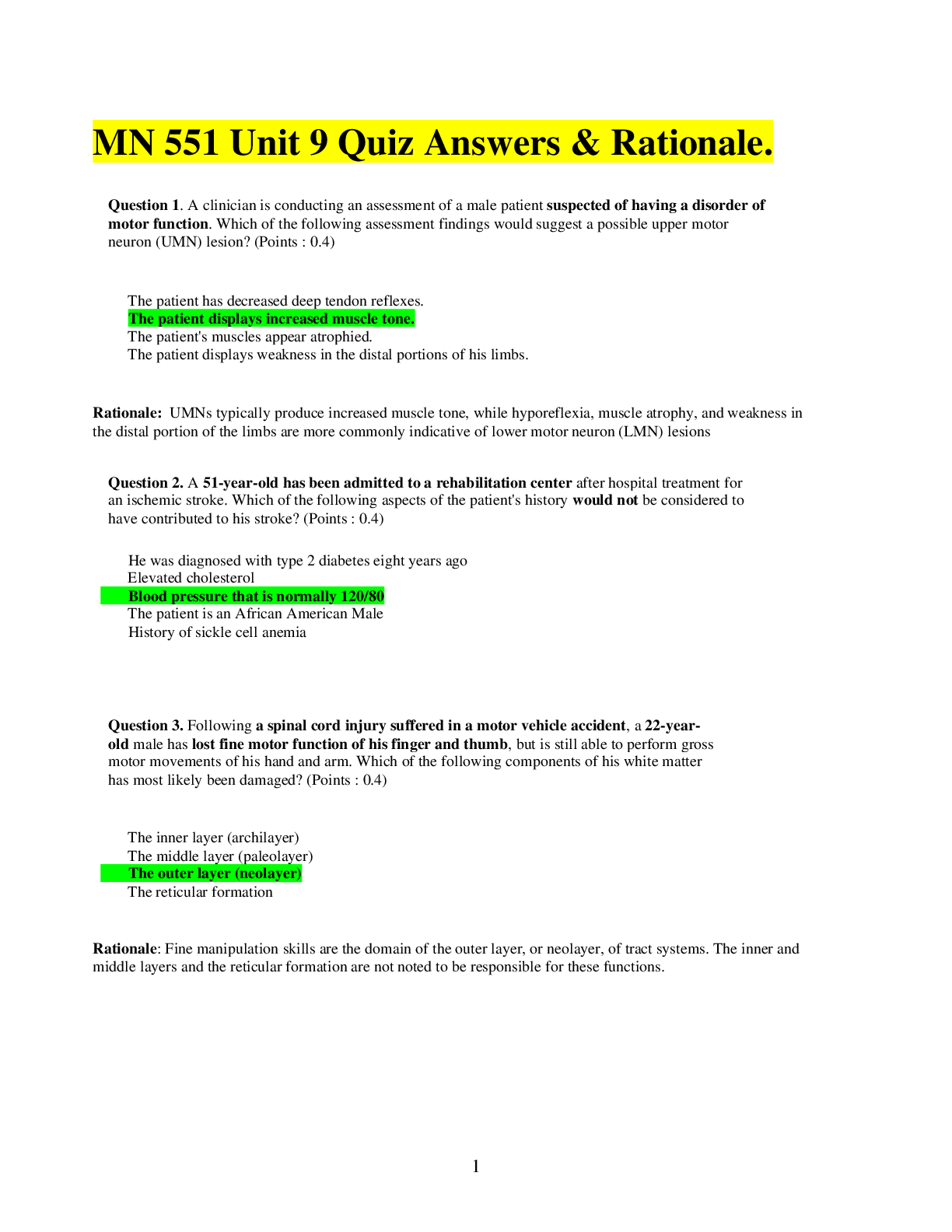*NURSING > QUESTIONS & ANSWERS > MN 551 Unit 9 Quiz Answers & Rationale, Complete solutions, Kaplan University, Davenport. (All)
MN 551 Unit 9 Quiz Answers & Rationale, Complete solutions, Kaplan University, Davenport.
Document Content and Description Below
Question 1. A clinician is conducting an assessment of a male patient suspected of having a disorder of motor function. Which of the following assessment findings would suggest a possible upper motor ... neuron (UMN) lesion? (Points : 0.4) The patient has decreased deep tendon reflexes. The patient displays increased muscle tone. The patient's muscles appear atrophied. The patient displays weakness in the distal portions of his limbs. Rationale: UMNs typically produce increased muscle tone, while hyporeflexia, muscle atrophy, and weakness in the distal portion of the limbs are more commonly indicative of lower motor neuron (LMN) lesions Question 2. A 51-year-old has been admitted to a rehabilitation center after hospital treatment for an ischemic stroke. Which of the following aspects of the patient's history would not be considered to have contributed to his stroke? (Points : 0.4) He was diagnosed with type 2 diabetes eight years ago Elevated cholesterol Blood pressure that is normally 120/80 The patient is an African American Male History of sickle cell anemia Question 3. Following a spinal cord injury suffered in a motor vehicle accident, a 22-year- old male has lost fine motor function of his finger and thumb, but is still able to perform gross motor movements of his hand and arm. Which of the following components of his white matter has most likely been damaged? (Points : 0.4) The inner layer (archilayer) The middle layer (paleolayer) The outer layer (neolayer) The reticular formation Rationale: Fine manipulation skills are the domain of the outer layer, or neolayer, of tract systems. The inner and middle layers and the reticular formation are not noted to be responsible for these functions. Question 4. A 44-year-old female has been diagnosed with major depression. Which of the following neuroimaging findings is most congruent with the woman's diagnosis? (Points : 0.4) Decreased brain activity in the pons and brain stem Reduced activity and gray matter volume in the prefrontal cortex Atrophy and decreased blood flow in the amygdala Enlargement of the lateral and third ventricles and reduction in frontal and temporal volumes Rationale: In some cases of familial major depressive disorder and bipolar disorder, PET and MRI studies have Question 26. When reviewing the purpose/action of neurotransmitters as they interact with different receptors, the nursing instructor gives an example using acetylcholine. When acetylcholine is released at the sinoatrial node in the right atrium of the heart, it is: positively charged inhibitory overstimulated dormant Rationale: The action of a transmitter is determined by the type of receptor to which it binds. Acetylcholine is excitatory when it is released at a myoneural junction, and it is inhibitory when it is released at the sinoatrial node in the heart. Question 27. A toddler is displaying signs and symptoms of weakness and muscle atrophy. The pediatric neurologist suspects it may be a lower motor neuron disease called spinal muscular atrophy (SMA). The patient's family asks how he got this. The nurse will respond: This could result from playing in soil and then ingesting bacteria that are now attacking his motor neurons. No one really knows how this disease is formed. We just know that in time, he may grow out of it. This is a degenerative disorder that tends to be inherited as an autosomal recessive trait. This is a segmental demyelination disorder that affects all nerve roots and eventually all muscle groups as well. Question 28. A child is experiencing difficulty with chewing and swallowing. The nurse knows that which of the following cells may be innervating specialized gut-related receptors that provide taste and smell? Special somatic afferent fibers General somatic afferents Special visceral afferent cells General visceral afferent neurons Question 29. While assessing a critically ill patient in the emergency department, the nurse notes on the cardiac monitor an R-on-T premature ventricular beat that develops into ventricular tachycardia (VT). Immediately, the patient became unresponsive. The nurse knows that based on pathophysiologic principles, the most likely cause of the unresponsiveness is: metabolic acidosis that occurs spontaneously following any dysrhythmias. interruption of the blood/oxygen supply to the brain. massive cerebrovascular accident (CVA) resulting from increased perfusion. a blood clot coming from the heart and occluding the carotid arteries. Question 30. The parents of a 3-year-old boy have brought him to a pediatrician for assessment of the boy's late ambulation and frequent falls. Subsequent muscle biopsy has confirmed a diagnosis of Duchenne muscular dystrophy. Which of the following teaching points should the physician include when explaining the child's diagnosis to his parents? Your son's muscular dystrophy is a result of faulty connections between muscles and the nerves that normally control them. He'll require intensive physical therapy as he grows up, and there's a good chance that he will outgrow this problem as he develops. Your son will be prone to heart problems and decreased lung function because of this. His muscles will weaken and will visibly decrease in size relative to his body size throughout his childhood. Question 31. Following a car accident of a male teenager who did not have his seatbelt on, he arrived in the emergency department with a traumatic brain injury. He has severe cerebral edema following emergent craniotomy. Throughout the night, the nurse has been monitoring and reporting changes in his assessment. Which of the following assessments correspond to a supratentorial herniation that has progressed to include midbrain involvement? Select all that apply. A) Clouding of consciousness B) Decorticate posturing with painful stimulation C) Pupils fixed at approximately 5 mm in diameter D) Re [Show More]
Last updated: 1 year ago
Preview 1 out of 9 pages
 2021.png)
Reviews( 0 )
Document information
Connected school, study & course
About the document
Uploaded On
Sep 27, 2021
Number of pages
9
Written in
Additional information
This document has been written for:
Uploaded
Sep 27, 2021
Downloads
0
Views
57

.png)
.png)
.png)
.png)
.png)
.png)
.png)
.png)
.png)
.png)
.png)

.png)

.png)
.png)















